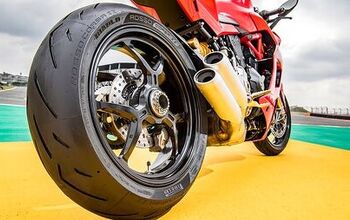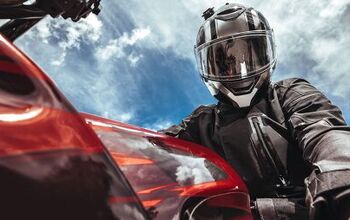Best Motorcycle Racing Tires You Can Also Use On The Street

The stickiest rubber short of a slick
In our Best Sportbike Tire series, we compiled a list of sportbike tires primarily suited for spirited street riding. In this, our Best Motorcycle Racing Tires series, we’re catering to the hardcore track rider, or even club racer, who still fancies the odd street ride. If you fall in that category, this list is for you. Here we’ve compiled some of the best track rubber you can find while still being approved by the Department of Transportation. In case you didn’t get the subtle hint, you won’t find any slicks on this list, but what we have here are nearly as good. As with many things in life, there’s a catch – some of these tires you’ll have to get through your local track vendor and can’t necessarily buy online. To put a positive spin on this scenario, at least you can feel good knowing you’re supporting a local business. Better still, your local track vendor will have the best advice as to what tire pressures to set for your local riding areas. Where possible, we’ve linked to Motorcycle.com staff member reviews of said tire(s), so here they are.
Table of Contents
Editor's Pick: Pirelli Diablo Supercorsa SP V3
Visually, this, the third generation of the Pirelli Diablo Supercorsa SP, looks a lot like all the other Supercorsa variations spanning the last decade. This isn’t a coincidence. As the spec tire supplier for the World Superbike championship, Pirelli knows when something works, and this tread pattern clearly does. Underneath the lightning bolt tread sipes, however, things are definitely different.
A multi-radius profile ensures uniform distribution of force over the contact patch, which is important considering the extreme power output of today’s 1000cc-plus sportbikes. In addition, the new profile maximizes contact at extreme lean angles. As the street-biased SP model, new compounds take advantage of the new tire profile resulting in a tire that heats up quickly and grips well in various conditions (for hardcore track or race riders, the Supercorsa SC version is for you and is available through your local trackside vendor). A re-designed “flash” tread pattern responds better to lateral forces compared to the previous tread pattern and improves stability when riding aggressively.
Road Test Editor Troy Siahaan has personal experience with these tires, having ridden them at numerous track events including the 2021 Honda CBR1000RR-R intro and the 2021 Aprilia RSV4 intro, both with and without tire warmers. Each time he’s come away very impressed with the tire’s ability to warm up quickly without warmers, and the loads of grip they provide for a DOT-legal street tire.
Avon 3D Ultra Evo
Avon’s latest track tire, the 3D Ultra Evo is one of three tire choices for the hardcore track rider – the other two being the 3D Ultra Xtreme Slick and Xtreme Rain Racer.
Designed, developed, and manufactured in the UK, the 3D Ultra Xtreme Slick and Xtreme Rain Racer are designed specifically for track day enthusiasts and club level competitions, while the 3D Ultra Evo is a road-going extension of the range, replacing the 3D Ultra Sport.
Compared to the 3D Ultra Sport, the Evo sees an all-new compound formulation to get up to temperature better and provide great grip and feedback. The race-derived construction was aided by multi-time British champion Steve Plater, giving the rider precise handling on the road or track. Lastly, the 3D sipe technology offers impressive grip for a track tire, even when there’s a little moisture on the ground.
Bridgestone R11
Bridgestone may no longer be the sole tire supplier for MotoGP, but the lessons learned from its long run producing tires for the fastest motorcycles on the planet have trickled down to the Battlax R11. The successor to the popular R10, the R11 takes advantage of B-Stone’s Ultimate Eye technology, first developed for Formula 1, to fully understand the tire’s abrasion angle and deformation during usage. The shape and design of the grooves are then made to optimize tread rigidity when cornering and also offer more stability leaned over or under power. The Variable Mono Spiral Belt construction gets tweaked from the R10, but still places the belts farther apart on the sides and closer together in the center for optimum grip and stability. While all this tech talk might be boring, the end result is a tire that’s truly impressive when it comes to optimum stick and maximum feedback, with very impressive wear. We know this because Trizzle sampled the tires on all three of Yamaha’s sportbikes – the R3, R6, and R1 – and came back thoroughly satisfied with their performance.
Linked below is the Bridgestone RS11, the “street” version of the R11 tire described above. Don’t let the S in the name fool you, despite the small compound change to better suit the street environment, these tires still offer great grip and incredible track performance.
Dunlop Q4
Borrowing from the lessons learned creating the GP-A Pro, Dunlop created the Sportmax Q4 for the track rider who maybe isn’t so committed about ultimate lap times, but just wants to enjoy their time on the track with as minimal upkeep as possible. The major difference between the Q4 and almost all of the other tires here is the Q4’s ability to get up to temperature extremely quickly – eliminating the need for tire warmers. Typically, a high silica content is the recipe for fast warm-up times, but the Q4 uses a 100% carbon-black recipe with proprietary polymers and resins to achieve proper warm-up without warmers. Dunlop’s Jointless Tread technology is the same method used to create the race tires and allows for the tread to be extruded directly onto the tire’s carcass in one continuous strip. CFT, or Carbon Fiber Technology is used in the sidewalls to increase stiffness, and you can see the aggressive tread pattern meant to provide as big a contact patch to the ground as possible. While Trizzle was slightly let down by the ultimate grip and excessive tire wear in his review of the Q4, he did praise the tire for its fast warm-up and ability to achieve impressive lean angles. Depending on your skill, budget, and track intent, the Q4 could be the pick for you.
Metzeler Racetec RR K2
Metzeler’s approach to creating a worthy track tire is to develop on the street. But not just any street – we’re talking the Isle of Man TT, among others. The TT’s unique environment and length allow Metzeler to develop a very unique tire, and the Racetec RR is proof. The single-compound front tire blends a selection of polymers and resins with different grades of carbon black to maximize hysteresis. The front also conforms to the micro-granularity of tarmac to deliver more grip and wear resistance and to last longer on severe asphalt. This blend of polymers also allows high flexibility at lower temperatures. The dual-compound rears feature a highly conductive center strip, which supports the shoulder compound from underneath and warms it up during long straights by redistributing the heat generated to the shoulders, maintaining them in the operative temperature and ensuring grip when going into lean. The crown and sidewalls are designed as a flexible system to dampen shocks from the road, yet the stiff ply material and 0º steel belts provide lateral stiffness once you lean the bike over or accelerate hard.
Michelin Power Cup 2
The Michelin Power Cup 2 takes full advantage of Michelin’s MotoGP involvement and delivers a tire for the general public aimed at living most of its life at the racetrack. Michelin says the Power Cup 2 is designed “for the most powerful two-wheeled machines” and is perfectly fine spending 95% of its time at the track. A minimal amount of tread grooves makes it DOT-legal for the street, but only just.
Safe and predictable to use with or without tire warmers, the Power Cup 2 offers great communication with very few setup changes needed on your motorcycle. Dual compound construction puts a harder tread compound in the center ground to cope with aggressive throttle application and give more stability under braking. Meanwhile, a softer compound increases grip at the tire’s shoulder. Adaptive Casing Technology (ACT) matches these high levels of dry grip with communicative response from the carcass and sidewall at all angles of lean.
What is the best brand of motorcycle tires?
The good news is all the brands listed here really do make high-quality tires. While it’s true different manufacturers have different philosophies as to what characteristics they want their tires to have, by no means are any of these tires unsafe to use. Just like choosing a motorcycle, in a way choosing a tire brand depends on what qualities you’re looking for. And if we’re really being honest, most of the time it depends on what deal you can get on a set when you’re looking. However, if there’s one thing you shouldn’t skimp out on, it’s tires.
What is the longest-lasting motorcycle tire?
This holds true for several tire types, but especially track tires – longevity is dependent on so many variables, it’s impossible to claim one lasts longer than another. Motorcycle type, rider type and skill, the track surface itself, and whether or not the rider properly inflated their tire are but many factors that play into a track tire’s lifespan. Then there’s the matter of traction – if you want maximum grip, then you’re going to give up longevity. Conversely, a long lifespan comes at the expense of traction. If you’ve decided a track tire is what you want, then be prepared to bulk up your tire budget.
When do you change motorcycle tires?
The easy answer is when you see cords showing, but obviously, it’s more nuanced than that. Especially when it comes to track tires. Motorcycle tires have wear bars spaced throughout the tire (a series of small, horizontal “bars”) that are as thick as the minimum tread depth. When your tire is worn to the point that these bars are no longer recessed below your tread, that’s one indicator it’s time to change tires.
With track tires, however, they experience several heat cycles – when the tire comes up to working temperature then cools off to ambient temp. Track tires specifically can only endure so many heat cycles before their performance starts to drop off, sometimes considerably, despite the tread depth being nowhere near the wear bar. The best indicator of this drop off will simply be a feeling of less grip everywhere. Obviously, at that point, it’s time to change your tires.
Additional Resources
MO Tested: Pirelli Supercorsa TD Review
Riding The Pirelli Diablo Supercorsa Tire Range
Riding The New Bridgestone Battlax R11 DOT Race Tire
MO Tested: Bridgestone Battlax Hypersport S22 Review
We are committed to finding, researching, and recommending the best products. We earn commissions from purchases you make using the retail links in our product reviews. Learn more about how this works.
Become a Motorcycle.com insider. Get the latest motorcycle news first by subscribing to our newsletter here.

Troy's been riding motorcycles and writing about them since 2006, getting his start at Rider Magazine. From there, he moved to Sport Rider Magazine before finally landing at Motorcycle.com in 2011. A lifelong gearhead who didn't fully immerse himself in motorcycles until his teenage years, Troy's interests have always been in technology, performance, and going fast. Naturally, racing was the perfect avenue to combine all three. Troy has been racing nearly as long as he's been riding and has competed at the AMA national level. He's also won multiple club races throughout the country, culminating in a Utah Sport Bike Association championship in 2011. He has been invited as a guest instructor for the Yamaha Champions Riding School, and when he's not out riding, he's either wrenching on bikes or watching MotoGP.
More by Troy Siahaan









































Comments
Join the conversation
Power RS is a race tire? Thought they were only for occasional track days and mostly for sport riding on the roads. I guess I overbought.
Pirelli race tires are the best and the service from MOTO-D ships them same day > https://www.motodracing.com...